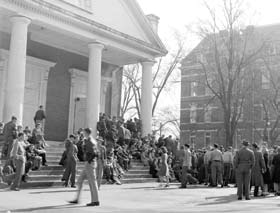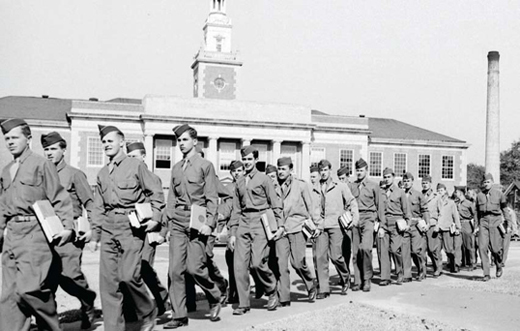|
A Centennial of Auburn Engineering:
|
|||||||||||||
 |
| Student gathre in front of Landon Hall as war is declared against the Axis powers. |
In 1938, the 74-year-old dean of engineering hired an assistant dean, Joshua Eyre Hannum, a graduate of Pennsylvania State College with bachelor’s and master’s degrees in mechanical engineering. In 1939, for the first time, the School of Engineering received accreditation of the mechanical and electrical engineering curricula from the Engineers’ Council for Professional Development (ECPD). Formed in 1932 by seven engineering societies, ECPD would become an important factor in the growth and survival of engineering at Auburn, what we know today as ABET, the accrediting body for college and university programs in applied science, computing, engineering and technology. In his report to the accreditation agency, Wilmore said that more than 3,000 students had graduated in engineering since API’s founding in 1872.
 |
| President Duncan shakes FDR's hand...the last sitting president to visit the campus iuntil the second Bush administration |
 |
The dean wrote that Auburn engineering graduates worked in private industry, the military, government and academia, and that almost all of them were men, with the exception of “Miss Maria R. Whitson,” who the report listed as “the First girl to graduate in Electrical Engineering.” Indeed, with a bachelor’s degree in 1923 and an electrical engineer professional degree in 1931, Whitson began her career with the Alabama Power Company; in 1939, she switched careers and taught elementary school in Talladega.
The 77-year-old dean of engineering prepared a report reviewing the progress made by the School of Engineering during the five-year period between 1935 and 1940. The school’s enrollment increased by two-thirds to 833 students and he wrote, “Practically every industry doing a national business in the United States has one or more Auburn graduates with them.”
As the nation again considered the possibility of war in 1940, API began a flight-training program as part of the Civilian Pilot Training program and enrollment in aeronautical engineering – begun in 1930 – grew by more than 60 percent. As the School of Engineering expanded its involvement in the federal Engineering, Science and Management Training Program in 1941, API organized classes in Birmingham, Montgomery and Mobile to train a thousand men in night classes.
On that Sunday afternoon in December when the Japanese Navy bombed Pearl Harbor, the management of the Tiger Theater stopped the film to announce to a house packed full of students that America had been attacked. The next day, Duncan called an executive council meeting “to determine API’s role in the war effort and to stress the need for calm among students and faculty.” As in 1917, the war would change life at Auburn, but nobody could predict by how much in the early days of World War II. The 1942 Catalogue announced Auburn’s change to the quarter system and on June 8, API began year-round operation, permitting students to graduate in three instead of four calendar years by attending classes in summer. “The entire curriculum has been revised and strengthened in accordance to wartime requirements,” said the catalogue, and “More than 95 percent of the men enrolled . . . are preparing themselves to meet the Nation’s wartime need for college-trained officers . . . or for special service in ‘critical occupations.’”
In 1943, Hannum became acting dean following the death of Wilmore at age 79, after 55 years at API. The trustees passed a resolution noting with “a measure of sadness and grief” the passing of the long-serving teacher, mentor and administrator. They said, “Death has come at last to Dean John J. Wilmore after a full life of distinguished service to Auburn, to Alabama and to the nation . . . the Engineering School was his life, and it remains his monument.”
At the time of Wilmore’s death, regular engineering enrollment shrank by almost half as students were called into the service. Meanwhile, total college enrollment peaked at 4,616 during the winter of 1942-1943 but fell to 2,290 the following year when women outnumbered men as regular students for the first time. In addition to their normal academic teaching loads, the engineering faculty were called upon to manage defense training programs. By June 1944, Auburn had trained nearly 35,000 men and women in wartime training programs, most administered and taught by the School of Engineering.
 |
| WWII soldiers mobilize in front of Ross Hall as Alabama Polytechnic Institute undertakes Army special training programs. |
Engineering E-Mag is a service of the Samuel Ginn College of Engineering. This newsletter is distributed to alumni and friends throughout the year.
To read archived copies visit: http://www.eng.auburn.edu/.
To learn more about the Samuel Ginn College of Engineering, visit our Web site at:http://www.eng.auburn.edu/.
QUESTIONS about Engineering E-Mag may be directed to Michael Stone, Webmaster for the Samuel Ginn College of Engineering, at webmaster@eng.auburn.edu
Auburn University is an equal opportunity educational institution/employer.


